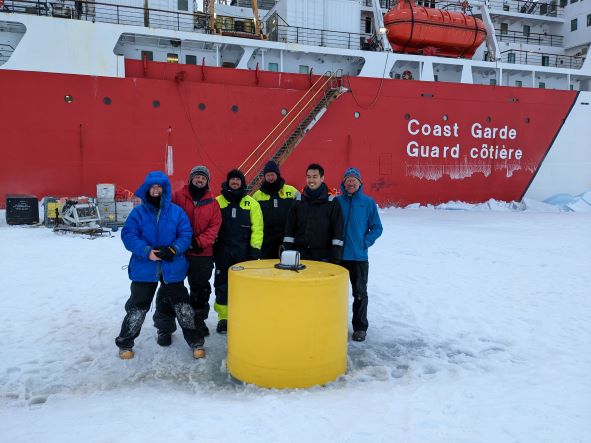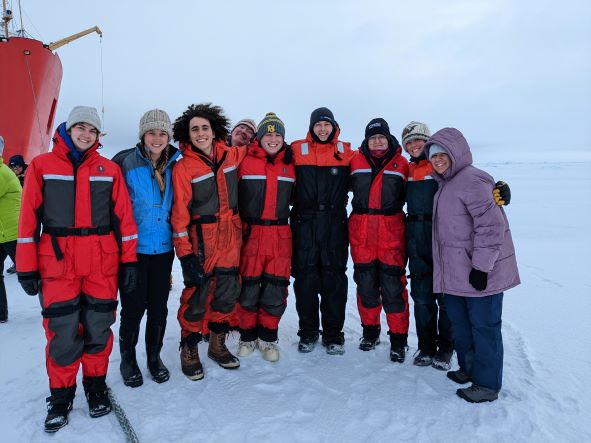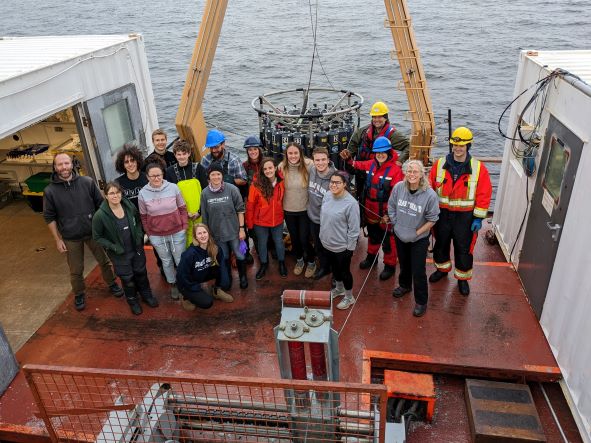Dispatch 27: Goodbye Louis! And Thank You!
Elizabeth Bailey
October 12, 2022
After 28 days aboard the Louis S. St-Laurent, we’re all looking forward to disembarking tomorrow and going back home. Overall, it has been an incredibly successful year for this program. With 26 members of the science team and 50 crew including the captain, operations were able to happen 24/7 – aiding in the success of our extensive sample and data collection, as well as instrument deployments.
The recovery and deployment of 3 Beaufort Gyre Observing System (BGOS) moorings took place over the course of 6 days throughout the expedition in operations led by the team from WHOI (Woods Hole Oceanographic Institution). Together these moorings include nearly 40 individual sensors and detectors that will be collecting data on the entire water column – from 30 meters below the sea surface all the way to the ocean floor at 3,800 meters. This data will provide this year’s information on the Beaufort Gyre, including sea level fluctuations, water column velocities, and much more. In addition to the mooring operations, we were able to deploy 4 Ice-Tethered Profilers (ITPs), 3 Tethered Ocean Profilers (TOPs), 2 Ice Mass Balance Buoys, and 1 Arctic Ocean Flux Buoy. All of those instruments are expected to transmit at least one year’s worth of high-resolution data returned via satellite in near-real-time and most are already online and reporting! For example, the ITPs together have reported 237 profiles and the TOPs have transmitted 513 profiles as of this morning.
In the 25 days of science operations, we were able to collect 10,280 liters of seawater with the Rosette. This amounted to over 7,000 individual samples taken from the Rosette! Many of these samples have already been analyzed in ship-based labs, including 1,909 nutrient samples, 984 oxygen samples, and 416 FDOM (fluorescent dissolved organic matter) samples. In addition, most of the 1,116 salt and 777 DIC/alkalinity samples taken have also already been analyzed throughout the expedition (about 30 to 40 of these samples will be shipped to labs onshore for analysis). There will still be many samples to analyze and process in labs onshore in the next few months, such as the 465 chlorophyll samples, 688 O-18 samples, 353 bacteria samples, and 32 zooplankton hauls.
All of those numbers do not include the samples takes for the independent research projects that have been supported by this program. These projects include research led by Celine Gueguen (there are almost 300 samples for her lab to process), sample collection for prokaryote DNA analysis (Susie McLatchie collected and filtered nearly 2,000 liters of water by herself!), water collection for radiogenic isotope analysis (over 1,200 liters of water will eventually make its way to Switzerland processing), and transparent exopolymer particle samples. During ice stations, we collected 9 ice cores and completed 4 transects of ice thickness measurements (almost 50 drilled ice thickness holes over two days!).
Finally, from all of the scientists and researchers, we would like to say thank to the crew and captain of the Louis S. St-Laurent! The last month at sea would not have been successful without the diligent work from the crew and captain. From preparing our meals to assisting with deck operations, none of this would have been possible without their aide!
In the years to come, we look forward to future iterations of this expedition. From maintaining many of the long-standing timeseries established by this program to supporting student research projects, this program has come to support a diverse body of science and enhanced our knowledge of the Beaufort Gyre, as well as the Arctic Ocean as a whole. It’s exciting to imagine what else can be accomplished in the years to come!


